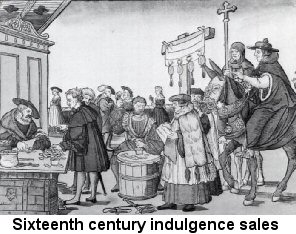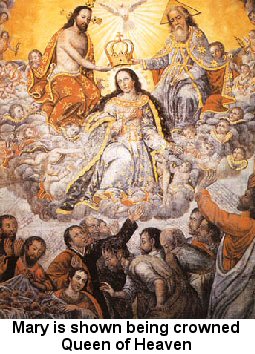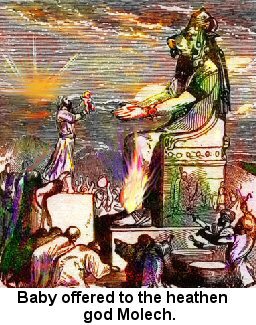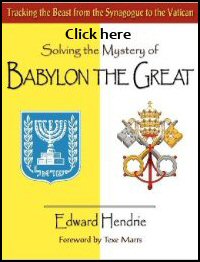Chapter Nine
RELIGIOUS FRAUD
THE SALE OF RELICS, church offices, and indulgences
became big business within the church of the Middle Ages.
Pope Boniface VIII declared a jubilee for the year 1300 and
offered liberal indulgences to those who would make a pilgrimage
to St. Peter's. An estimated 2,000,000 people came within
that year and deposited such treasure before the supposed tomb of
St. Peter that two priests with rakes in their hands were kept
busy day and night raking up the money. Much of this was
used by the pope to enrich his own relatives--the Gaetani--who
bought numerous castles and splendid estates in Latium. This
was strongly resented by the people of Rome.
From the days of Constantine, the
Roman church had increased in wealth at a rapid pace. In the
Middle Ages, the church owned entire cities and large portions of
land. Those who lived in Catholic countries were required to
pay taxes to the church. This was not giving from the heart,
but fees paid "of necessity"--a principle which was opposed by the
apostle Paul (2 Cor.9:71).
In those days, few people knew how
to write, so priests were often involved in drafting wills.
In 1170 Pope Alexander III decreed that no one could make a valid
will except in the presence of a priest! Any secular notary
who drew up a will (except under these circumstances) was to be
excommunicated! Often a priest was the last person to be
with a dying man, for he would give the last rites, the Extreme
Unction. With such arrangements, we can be sure the Romish
church was well remembered.

The selling of indulgences provided another source of
income. So that there will be no misunderstanding as to just
what an indulgence is in Catholic belief, we will go right to The
Catholic Encyclopedia. Here it is explained that sins
committed after baptism (which for a Catholic is usually in
infancy!) can be forgiven through the sacrament of penance, "but
there still remains the temporal punishment required by Divine
justice, and this requirement must be fulfilled either in the
present life or in the world to come, in Purgatory. An
indulgence offers the penitent sinner the means of discharging
this debt during this life on earth." This point should be
carefully noted
To go a step further, we should
consider the basis, according to Catholic belief, or which
indulgences are granted. The Catholic Encyclopedia says the
basis or source for indulgences is the "treasury." This
includes the infinite redemptive work of Christ who is the
propititiation for sins (1John 2:2), "besides"--notice the
word!--"there are the satisfactory works of the Blessed Virgin
Mary undiminished by any penalty due to sin, and the virtues,
penances, and sufferings of the saints vastly exceeding any
temporal punishment which these servants of God might have
incurred." Because of the works these have performed, there
is an extra supply or treasury of merits--merits which make it
possible for indulgences to be shared with others of the church
who have not been as saintly! Such was the doctrine dogmatically
set forth in the Bull "Unigenitus" of Clement VI in 1334.
"According to Catholic doctrine, therefore, the source of
indulgences is constituted by the merits of Christ and the
saints"!
But if Christ "is the propitiation
for our sins" and his blood "cleanseth us from all sin" (1 John
1:7; 2:2), in what way can the merits of Mary and other saints
possibly add to this? What Mary or other saints did can add
nothing to the completed work of Christ at Calvary. To us,
such rigamarole provides no support for the indulgence doctrine,
but identifies it, rather, as a man-made fabrication.
Without a proper scriptural
foundation, it is no wonder the idea of indulgences led to many
abuses. Because granting indulgences was commonly linked with
money, even The Catholic Encyclopedia makes such statements as:
"the practice was fraught with grave danger, and soon became a
fruitful source of evil...a means of raising money...indulgences
were employed by mercenary ecclesiastics as a means of pecuniary
gain.. .abuses were widespread"!
One of the abuses was that some
who sold indulgences to sinners were great sinners
themselves. About 1450, Thomas Gascoigne, Chancellor of
Oxford University, complained that the indulgence sellers would
wander over the land and issue a letter of pardon, sometimes for
the payment of two pence, sometimes for a glass of beer, for the
hire of a harlot, or for carnal love.
At the time of Martin Luther, because of construction work on St.
Peter's, a special drive was made by the pope to raise money through
the granting of indulgences. John Tetzel, known to be a man of
poor conduct, but one who had ability as a quack fund raiser, was
appointed to sell indulgences in Germany. The following is
given as an eyewitness description of Tetzel's entry into a German
town:
"When the indulgence seller
approached the town, the Bull (the pope's official document) was
carried before him on a cloth of velvet and gold, and all the
priests and monks, the town council, the schoolmasters and their
scholars, and all the men and women went out to meet him with
banners and candles and songs, forming a great procession; then
with bells ringing and organs playing, they accompanied him to the
principal church; a cross was set up in the midst of the church
and the pope's banner displayed; in short, one might think they
were receiving God himself. In front of the cross was placed a
large iron chest to receive the money, and then the people were
induced in various ways to buy indulgences."
It is said that Tetzel carried
with him a picture of the devil tormenting souls in Purgatory and
frequently repeated the statement that appeared on the money
box: Sobaid der pfennig im kasten kliggt, kie seel' aus dem
Fegfeuer springt, which freely translated means, "As soon as the
money in the casket rings, the troubled soul from Purgatory
springs." The rich gave large donations, while poverty
stricken peasants sacrificed what they could in order to help
their loved ones in Purgatory or to obtain pardon for their own
sins.
In Medieval universities, those
who wished to advocate certain opinions would publicly post
"theses"--statements of their ideas--and invite discussion on
these points. Following this custom, Martin Luther nailed
his famous Ninety-five Theses to the door of the Castle Church in
Wittenberg, Germany. (His twenty--seventh point was against the
idea that as soon as money went into the collection box that souls
would escape from Purgatory.) It was not at the Castle
Church, however, that Tetzel held his meetings. Indulgence
preaching was not allowed in Wittenberg, but many people had gone
from there to hear Tetzel at Juterbog, a nearby town.
Luther began to speak out against
the selling of indulgences,
and, eventually, against indulgences as such. He was
denounced by Pope Leo X for saying, "Indulgences are pious
frauds....Indulgences do not avail those who gain them for the
remission of the penalty due to actual sin in the sight of God's
Justice."
The Reformation did a good job of
exposing the idea that the buying of indulgences could free souls
from Purgatory--and today that concept would not be promoted in
the way it was at one time. Nevertheless, even today, there
is still a linkage between giving money and prayers for the
dead. Since priests must admit they have no way to know when
souls actually pass out of Purgatory into Heaven, there is never
really a settled peace in the matter. There is always the
possibility that more money should be given on behalf of loved
ones who have died. To play upon the love and tender
memories of bereaved people, to take money for masses and long
prayers, brings to mind those Jewish priests at the time of Jesus
who would "devour widows" houses, and for a pretence make long
prayer" (Matt. 23:14).
High Mass can be very expensive,
depending on the flowers, candles, and number of priests taking
part. It is sung in a loud tone of voice. The Low
Mass, or the other hand, is much less expensive--only six candles
are used and it is repeated in a low voice. The Irish have a
saying, High money, HIGH Mass; low money, LOW Mass; no money, NO MASS!"
Those who die without anyone to
pay for Masses in their behalf are called the "forgotten souls in
Purgatory." However, these are remembered in special prayers
on November 2, "All Soul's Day." If a Catholic fears he
might become one of the forgotten souls, he may join the
Purgatorian Society which was established in 1856. A
contribution each year to the society will assure him that,
upon his death, prayers will be said for his soul. During World
War II, the Archbishop of Winnipeg, in a letter dated March 1,
1944, urged Roman Catholic mothers to guarantee the salvation of
their sons from Purgatory by the payment to him of $40 for prayers
and Masses in their behalf.
I will say it here quite clearly,
whether he be Sun worship,
Papal, Protestant, or Pentecostal, no pope, priest, or preacher
can guarantee the salvation of anyone, living or dead, on the
basis of money given for his prayers. Jesus said it is hard
for a rich man to enter into the kingdom of heaven
(Matt.19:23,24). But if the payrment of money could help a
person escape from Purgatory and go to Heaven, Just the reverse
would be true. Instead of it being "hard" for a rich man to enter
heaven, riches would be a "help"!
The Bible says, "They that trust in their wealth, and boast
themselves in the multitude of riches; none of them can by any
means redeem his brother, nor give to God a ransom for him" (Psalms
49:6,7). If money cannot redeem a brother who is alive, how
could it redeem him if he is dead? There can be no mistake as
to where Peter stood on the matter. He plainly said we are
"NOT redeemed with corruptible things as silver and gold...but with
the precious blood of Christ, as of a lamb without blemish and
without spot" (1 Peter 1:18,19).
When the former Samaria sorcerer
offered Peter money to obtain a gift of God, Peter said: "To hell
with you and your money! How dare you think you could buy
the gift of God?" (Acts 8:20). These words are from the
translation by J. B. Philips, to which he adds a footnote: "These
are exactly what the Greek means. It is a pity that their
real meaning is obscured by modern slang."

Roman Catholic ideas about Purgatory
(and prayers to help those in Purgatory) were not the teachings of
Christ and the apostles. Such were not taught within the
Catholic church to any great degree until around 600 when Pope
Gregory the Great made claims about a third state--a place for the
purification of souls before their entrance into heaven. It
did not become an actual dogma" until the Council of Florence in
1459.
During the twelfth century, a
legend was spread which claimed that St. Patrick had found the
actual entrance to Purgatory. In order to convince some
doubters, he had a very deep pit dug tn Ireland, into which
several monks descended. Upon their return, said the tale,
they described Purgatory and Hell with discouraging
vividness. In 1153, the Irish knight Owen claimed he had
also gone down through the pit into the underworld. Tourists
came from far and near to visit the spot. Then financial
abuses developed and in 1497 Pope Alexander VI ordered it closed
as a fraud. Three years later, however, Pope Benedict XIV
preached and published at Rome a sermon in favor of Patrick's
Purgatory!
Beliefs about a purgatory have
been around a long time. Plato 1427-347 B.C.) spoke of the
Orphlc teachers of his day "who flock to the rich man's doors, and
try to persuade him that they have a power at their command, which
they procure from heaven, and which enables them by sacrifices and
incantation...to make amends for any crime committed by the
individual himself, or his ancestors....Their mysteries deliver us
from the torments of the other world, while the neglect of them is
punished by an awful doom."
There have been times when so many
Chinese Buddhists came to buy prayers for the deliverance of their
loved ones from Purgatory that special shops were set up for this
purpose. There is an elaborate description of purgatorial
suffering in the sacred writings of Buddhism. In the
religion of Zoroaster, souls are taken through twelve stages
before they are sufficiently purified to enter heaven. The
Stoics conceived of a middle place of enlightenment which they
called Empurosis, that is, "a place of fire."
The concept of giving money on
behalf of the dead is very ancient, a point which may be seen
within the Bible itself. Apparently the Israelites were
exposed to this belief, for they were warned not to give money
"for the dead" (Deut.26:14). After presenting detailed
evidence for his conclusion, Hislop says: "In every system,
therefore, except that of the Bible, the doctrine of purgatory
after death, and prayers for the dead, has always been found to
occupy a place."
It is very possible that concepts
about Purgatory and certain ideas linked with Molech worship stemmed from a
common source. It appears that various nations had the idea
that fire, in one way or another, was necessary to cleanse from
sin. The Israelites were repeatedly forbidden to
let their seed "pass through the
fire to
Molech"(Lev.
18:21, Jer. 32:35, 2 Kings 23:10).
Molech. (who some identify
with Bel or Nimrod) was worshiped "with human sacrifices,
purrifications...with mutilation, vows of celibacy and virginity,
and devotion of the firstborn." Sometimes he

was represented
as a horrible idol with fire burning inside so that what was
placed in his arms was consumed. In the pictue, a heathen
priest has taken a baby from its mother to be offered to
Molech. Lest the parents
should relent , a loud noise was made on drums to hide the
screams. The word for drums is tophim, from which comes the
word "Tophet," the place mentioned in verses such as Jeremiah
7:31: "They have built the high place of Tophet...to burn their
sons and their daughters in the fire." While drums sounded,
bands played, and priests chanted, human sacrifices were devoured
in the flames.
It is indeed sad that multitudes
of people have believed that such cruel rites, or the payment of
large sums of money, or human works, can pay for their sins. The
good news is that the price has already been paid--by Jesus
Christ! Salvation is by grace--by favor that could never be
merited by money, human works, or sacrifices, "For by GRACE are ye saved through faith; and that not of yourselves: it is the GIFT of God: not of works,
lest any man should boast" (Eph, 2:8,9).
“Signs and symbols rule the Sun Worship world, not
words nor laws.”
www.granddesignexposed.com
Preview "Solving the Mystery of Babylon the Great"

The research for this book began over ten
years ago. My first book was titled Antichrist
Conspiracy, Inside the Devil’s Lair. The book was
intended as an exposition on the unbiblical theology of the
Roman Catholic Church. As I researched the theology of
the Roman church, however, I discovered political, financial,
and media tentacles flowing from the core of what was supposed
to be a religious institution.
As I researched the Catholic religion and followed the
tentacles I discovered a connection between the Catholic
Church and Zionist Jews. The evidence was there,
but the connections were not overt, they were in the shadows,
concealed from view. It was clear that there was a synergism
between Judaic and Catholic interests. I followed the
evidence and reported my findings in Antichrist
Conspiracy. After publishing Antichrist
Conspiracy, I continued to dig deeper; I was able to
find more solid evidence of the connection between Rome and
Jerusalem. This book is the culmination of that research.
As I followed the tentacles from the Vatican I discovered that
the Jewish connection with Rome was not simply one of synergy
but rather one of control. I discovered credible
evidence that the Roman Catholic Church was established by crypto-Jews
as a false “Christian” front for a Judaic/Babylonian
religion. That religion is the core of a world
conspiracy against man and God. That is not a soft
conspiracy theory based upon speculation; it is the hard truth
supported by authoritative evidence, which is documented in
this book.
Edward Hendrie
April 2010
Quote page 48 Chapter7 Ignatius
Loyola himself was a crypto-Jew of the Occult Kabbalah.
A crypto-Jew is a Jew who converts to another religion
and outwardly embraces the new religion, while secretly
maintaining Jewish practices.
Below is from page
50-51 "Chapter 7, "
Crypto-Jewish Jesuits"
In ancient Palestine
the Jews worked hand in hand with the Romans to crucify
Christ. Now, the Jews work hand in glove
with the Roman Catholic Church in their effort to eradicate Christ’s
gospel. The great harlot of Babylon in
Revelation 17:5 has Mystery written upon her forehead. She
is called Babylon because she is Babylonian. She
is a mystery because she masquerading as “the” Christian
religion. Christian labels have been applied to
Babylonian paganism to come up with the mystery religion we
know as the Roman Catholic Church. Both the Talmudic Jews
and the Vatican share that common Babylonian root.
The Jesuits nurtured the Babylonian Cabalism in Roman
Catholic doctrine. The similarities between the
imperious whorish woman in Ezekiel 16:14-40 and the Mother of
Harlots in Revelation 17:5 are unmistakable.
They are one and the same. Roman Catholicism is an
esoteric version of Babylonian Judaism. The Roman Church
appears gentile to the uninitiated, but it is
Jewish to its core. Orthodox Judaism appears to the
uninitiated to be the Old Testament theology, but it is
actually Babylonian to its core.
 Roman Catholic ideas about Purgatory
(and prayers to help those in Purgatory) were not the teachings of
Christ and the apostles. Such were not taught within the
Catholic church to any great degree until around 600 when Pope
Gregory the Great made claims about a third state--a place for the
purification of souls before their entrance into heaven. It
did not become an actual dogma" until the Council of Florence in
1459.
Roman Catholic ideas about Purgatory
(and prayers to help those in Purgatory) were not the teachings of
Christ and the apostles. Such were not taught within the
Catholic church to any great degree until around 600 when Pope
Gregory the Great made claims about a third state--a place for the
purification of souls before their entrance into heaven. It
did not become an actual dogma" until the Council of Florence in
1459.
 was represented
as a horrible idol with fire burning inside so that what was
placed in his arms was consumed. In the pictue, a heathen
priest has taken a baby from its mother to be offered to
was represented
as a horrible idol with fire burning inside so that what was
placed in his arms was consumed. In the pictue, a heathen
priest has taken a baby from its mother to be offered to 